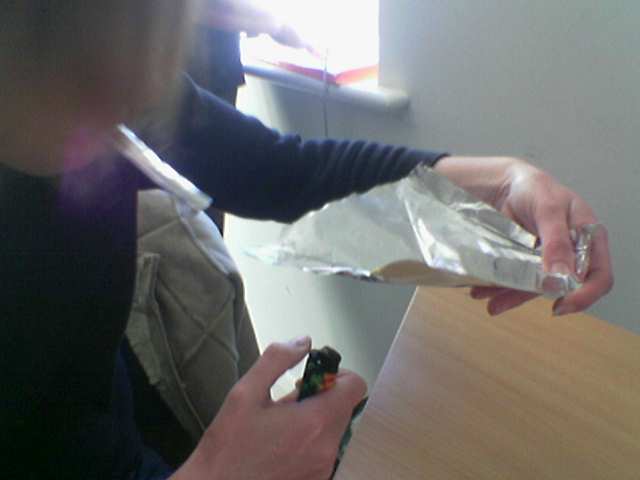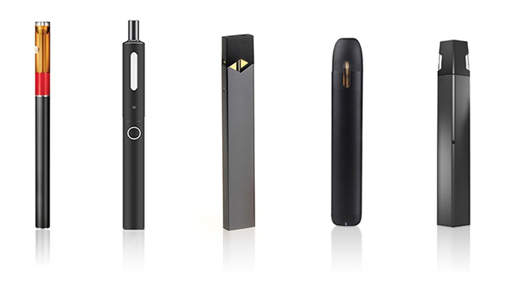|
Chasing The Dragon
"Chasing the dragon" (CTD) (), or "foily" in Australian English, refers to inhaling the vapor from a heated solution of a powdered psychoactive drug on a sheet of aluminum foil. The moving vapor is chased after with a tube (often rolled foil) through which the user inhales. The "chasing" occurs as the user gingerly keeps the liquid moving in order to keep it from overheating and burning up too quickly, on a heat conducting material such as aluminium foil. Another use of the term "chasing the dragon" refers to the elusive pursuit of a high equal to the user’s first in the use of a drug, which after acclimation is no longer achievable. Used in this way, “chasing the dragon” can refer to any recreational drug administered by any means. Etymology Chasing the dragon is a slang phrase of Cantonese origin from Hong Kong. The Hong Kong film Chasing the Dragon is named from the origin of the etymology. Cultural aspects Aluminum foil is considered to be low-quality drug paraphe ... [...More Info...] [...Related Items...] OR: [Wikipedia] [Google] [Baidu] |
Chasing The Dragon (film)
''Chasing the Dragon'' (), previously known as ''King of Drug Dealers'', is a Hong Kong-Chinese action crime drama film directed by Wong Jing and Jason Kwan. The film stars Donnie Yen as Crippled Ho, based on real life gangster Ng Sik-ho and Andy Lau reprising his role as Lee Rock from the film series of the same name. The film is about an illegal immigrant from Hong Kong who sneaks into British-colonized Hong Kong in 1963 and transforms himself into a ruthless and emerging drug lord. The film is a remake of the 1991 film '' To Be Number One''. '' Chasing the Dragon II: Wild Wild Bunch'', a sequel-in-name-only featuring new characters and a new storyline was released in June 2019. Cast * Donnie Yen as Crippled Ho (跛豪; based on Ng Sik-ho) * Andy Lau (special appearance) as Lee Rock (雷洛; based on Lui Lok) * Bryan Larkin as Ernest Hunter, a corrupt British policeman and the main antagonist of the film * Kent Cheng as Piggy * Philip Keung as Wil * Wilfred Lau as Wayne * ... [...More Info...] [...Related Items...] OR: [Wikipedia] [Google] [Baidu] |
Ya Ba
''Ya ba'' ( th, :wikt:ยาบ้า, ยาบ้า, lo, ຢາບ້າ, literally 'crazy medicine'), formerly known as ''yama'' ( th, :wikt:ยาม้า, ยาม้า; literally 'horse drug'), also known as "bikers' coffee" and "kamikaze", are tablets containing a mixture of methamphetamine and caffeine. The illicit use of this drug combination has been widespread, particularly in South and Southeast Asian countries. Alternative names From ''ya khayan'' ('hard-working pill') in its early days to ''ya maa'' ('horse medicine'), the drug was named ''ya ba'' ('crazy pill') in 1996. It was given to horses when pulling carts up steep hills and for other strenuous work in Shan State in Myanmar (formerly Burma). The slang terms for ''ya ba'' in Burma are ''kyethi'' (literally, 'button'), ''athi'', and ''palarkar''. In Malaysia, ''ya ba'' is known in Malay language, Malay as ''pil kuda'' (literally, 'horse pill'). It is commonly found in the state of Kelantan, on the border wit ... [...More Info...] [...Related Items...] OR: [Wikipedia] [Google] [Baidu] |
Talc
Talc, or talcum, is a Clay minerals, clay mineral, composed of hydrated magnesium silicate with the chemical formula Mg3Si4O10(OH)2. Talc in powdered form, often combined with corn starch, is used as baby powder. This mineral is used as a thickening agent and lubricant. It is an ingredient in ceramics, paints, and roofing material. It is a main ingredient in many cosmetics. It occurs as Foliation (geology), foliated to Fiber, fibrous masses, and in an exceptionally rare crystal form. It has a perfect cleavage (crystal), basal cleavage and an uneven flat fracture, and it is foliated with a two-dimensional ped, platy form. The Mohs scale of mineral hardness, based on Scratch hardness, scratch hardness comparison, defines value 1 as the hardness of talc, the softest mineral. When scraped on a streak (mineralogy), streak plate, talc produces a white streak; though this indicator is of little importance, because most silicate minerals produce a white streak. Talc is translucent to ... [...More Info...] [...Related Items...] OR: [Wikipedia] [Google] [Baidu] |
Cutting Agent
A cutting agent is a chemical used to "cut" ( dilute or adulterate) recreational drugs with something less expensive than the drug itself. Overview The classical model of drug cutting, according to Preble and Casey (1969), refers to the way that illicit drugs were diluted at each stage of the chain of distribution. Drug markets have changed considerably since the 1980s; greater competition, and a shift from highly structured (and thus controlled) to greatly fragmented markets, has generated competition among dealers in terms of purity. Many drugs that reach the street are now only cut at the manufacture/producer stage, and this may be more a matter of lacing the drug with another substance designed to appeal to the consumer, as opposed to simple diluents that increase the profit for the seller. The extent of cutting can vary significantly over time but for the last 15 years drugs such as heroin and cocaine have often sat at the 50% purity level. Heroin purity sitting at 50% ... [...More Info...] [...Related Items...] OR: [Wikipedia] [Google] [Baidu] |
Illicit Drug
The prohibition of drugs through sumptuary legislation or religious law is a common means of attempting to prevent the recreational use of certain intoxicating substances. While some drugs are illegal to possess, many governments regulate the manufacture, distribution, marketing, sale, and use of certain drugs, for instance through a prescription system. For example, amphetamines may be legal to possess if a doctor has prescribed them; otherwise, possession or sale of the drug is typically a criminal offense. Only certain drugs are banned with a "blanket prohibition" against all possession or use (e.g., LSD). The most widely banned substances include psychoactive drugs, although blanket prohibition also extends to some steroids and other drugs. Many governments do not criminalize the possession of a limited quantity of certain drugs for personal use, while still prohibiting their sale or manufacture, or possession in large quantities. Some laws (or judicial practice) set a sp ... [...More Info...] [...Related Items...] OR: [Wikipedia] [Google] [Baidu] |
Tablet (pharmacy)
A tablet (also known as a pill) is a pharmaceutical oral dosage form (''oral solid dosage'', or OSD) or solid unit dosage form. Tablets may be defined as the solid unit dosage form of medicament or medicaments with suitable excipients. It comprises a mixture of active substances and excipients, usually in powder form, pressed or compacted from a powder into a solid dose. Tablets are prepared either by molding or by compression. The excipients can include diluents, binders or granulating agents, glidants (flow aids) and lubricants to ensure efficient tabletting; disintegrants to promote tablet break-up in the digestive tract; sweeteners or flavours to enhance taste; and pigments to make the tablets visually attractive or aid in visual identification of an unknown tablet. A polymer coating is often applied to make the tablet smoother and easier to swallow, to control the release rate of the active ingredient, to make it more resistant to the environment (extending its shelf li ... [...More Info...] [...Related Items...] OR: [Wikipedia] [Google] [Baidu] |
Excipient
An excipient is a substance formulated alongside the active ingredient of a medication, included for the purpose of long-term stabilization, bulking up solid formulations that contain potent active ingredients in small amounts (thus often referred to as "bulking agents", "fillers", or "diluents"), or to confer a therapeutic enhancement on the active ingredient in the final dosage form, such as facilitating drug absorption, reducing viscosity, or enhancing solubility. Excipients can also be useful in the manufacturing process, to aid in the handling of the active substance concerns such as by facilitating powder flowability or non-stick properties, in addition to aiding ''in vitro'' stability such as prevention of denaturation or aggregation over the expected shelf life. The selection of appropriate excipients also depends upon the route of administration and the dosage form, as well as the active ingredient and other factors. A comprehensive classification system based on structure- ... [...More Info...] [...Related Items...] OR: [Wikipedia] [Google] [Baidu] |
Vaporizer (inhalation Device)
A vaporizer or vaporiser, colloquially known as a vape, is a device used to vaporize substances for inhalation. Plant substances can be used, commonly cannabis, tobacco, or other herbs or blends of essential oil. However, they can also be filled with a combination propylene glycol, glycerin, and drugs such as nicotine (e.g. extract from tobacco) or tetrahydrocannabinol as a liquid solution. Vaporizers contain various forms of extraction chambers including straight bore, venturi, or sequential venturi, and are made of materials such as metal or glass. The extracted vapor may be collected in an inflatable bag, or inhaled directly through a hose or pipe. When used properly, cooler temperatures due to lack of combustion result in significantly more efficient extraction of the ingredients. Hence, the irritating and harmful effects of smoking are heavily reduced, as is its secondhand smoke. Cannabis vaporizers Cannabis flower is commonly consumed using a dry herb vaporizer. The cann ... [...More Info...] [...Related Items...] OR: [Wikipedia] [Google] [Baidu] |
Drug Overdose
A drug overdose (overdose or OD) is the ingestion or application of a drug or other substance in quantities much greater than are recommended.Definitions Retrieved on 20 September 2014."Stairway to Recovery: Glossary of Terms" . Retrieved on 19 March 2021 Typically it is used for cases when a risk to health will potentially result. An overdose may result in a toxic state or . Classification [...More Info...] [...Related Items...] OR: [Wikipedia] [Google] [Baidu] |
Oral Administration
Oral administration is a route of administration where a substance is taken through the mouth. Per os abbreviated to P.O. is sometimes used as a direction for medication to be taken orally. Many medications are taken orally because they are intended to have a systemic effect, reaching different parts of the body via the bloodstream, for example. Oral administration can be easier and less painful than other routes, such as injection. However, the onset of action is relatively low, and the effectiveness is reduced if it is not absorbed properly in the digestive system, or if it is broken down by digestive enzymes before it can reach the bloodstream. Some medications may cause gastrointestinal side effects, such as nausea or vomiting, when taken orally. Oral administration can also only be applied to conscious patients, and patients willing and able to swallow. Terminology ''Per os'' (; ''P.O.'') is an adverbial phrase meaning literally from Latin "through the mouth" or "by mouth ... [...More Info...] [...Related Items...] OR: [Wikipedia] [Google] [Baidu] |
Needle Sharing
Needle sharing is the practice of intravenous drug-users by which a needle or syringe is shared by multiple individuals to administer intravenous drugs such as heroin, steroids, and hormones. This is a primary vector for blood-borne diseases which can be transmitted through blood (blood-borne pathogens). People who inject drugs (PWID) are at an increased risk for Hepatitis C (HCV) and HIV due to needle sharing practices. From 1933 to 1943, malaria was spread between users in the New York City area by this method. Afterwards, the use of quinine as a cutting agent in drug mixes became more common. Harm reduction efforts including safe disposal of needles, supervised injection sites, and public education may help bring awareness on safer needle sharing practices. Infections Blood-borne diseases are transmitted when a susceptible person uses a needle that was previously used by a person who is infected with these pathogens; hence, sharing needles with other individuals is not a safe pr ... [...More Info...] [...Related Items...] OR: [Wikipedia] [Google] [Baidu] |






